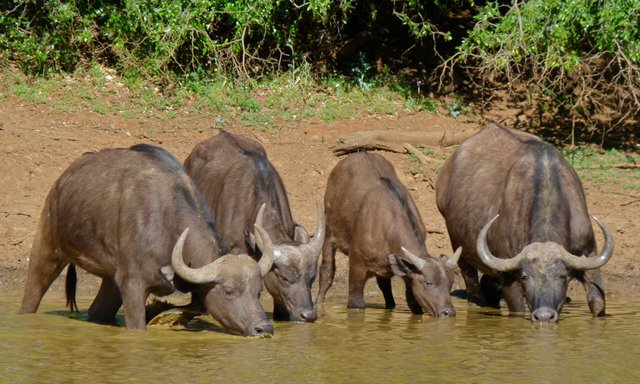Buffalo herds use a voting system to select their next grazing spot (Amazing Animal Adaptations #4)
In this part of the series on amazing animal adaptations, I am going to talk about voting behavior in nature, specifically in buffalo herds. I think this post in the series will be especially relevant to us Steemies who are actively voting all the time, so I hope you find this post enjoyable.
The African buffalo (Syncerus caffer) live in large herds of females and their offspring, with herds that can have hundreds of individuals. The males form sub-herds around the core herd, and at certain parts of the year they form bachelor groups. The African buffalo is generally considered a dangerous animal, and over 200 people die from African buffalo attacks every year. However, this post is not about their deadly horns, but instead about the complex social behavior they show when they choose a new grazing site.
An African buffalo. Image by Gouldingken, posted with the Creative Commons Attribution-Share Alike 3.0 Unported license.
The voting behavior in the African buffalo
The first evidence of the voting behavior of the buffalo herds came in 1996 when ecologist Herbert Prins had been following a herd of buffaloes for 2 years. During the heat of the midday sun, the buffalo herd would lay down and rest until dusk. At dusk they would keep moving to a new grazing site where they could forage during the evening. However, at seemingly random times one of the members would get up on its hooves, lift its head high and gaze in a certain direction. Prins had always been under the impression that they were doing this simply to stretch their legs, but one day he decided to systematically take note of the direction that the animal would gaze at.
The results from this was a clear pattern showing that the movement of the herd could be predicted from the amount of individuals who gazed in a certain direction. Most of the time the voting will go in favor of a specific direction, but if the herd disagrees, it can even split up for the night and graze on two separate spots. This last event only occurs when there is mixed opinion involving lots of animals, and if only a few of them disagrees with the consensus they will follow the herd to wherever the most popular opinion will lead them.
The voting system itself if simple, one buffalo start by gazing in a directing. The rest of the herd notices, but don't actively vote yet. If one of the other buffaloes agree, they will do the exact same behavior at the same direction. If they want another spot they simply gaze at that direction. During the resting time all the buffaloes get a change to gaze at their desired direction, and the one where most of the herd wants to go get chosen.
Some members of an African buffalo herd. Image by (WT-en) Jpatokal at English Wikivoyage with the Creative Commons Lisence.
A very interesting note on their voting behavior is that each vote is equal, and the dominance hierarchy in the herd does not affect voting power. This means that each buffalo has an equal say in the matter when choosing a new grazing direction, while the most dominant ones have a bigger impact on the results in other parts of their lives (such as when mating, or when selecting the best parts for grazing).
Why are they voting?
The theory as to why the animals are voting instead of simply following a leader is that pooling information together will reduce the chance of making extreme errors, and on average result in the best overall solution. The voting is done while the herd is resting, so they do not waste lots of time on the process, so it is a win-win type of situation.
Voting behavior is somewhat common in the animal kingdom, but we usually find it in eusocial insect societies rather than in mammal societies. There are of course exceptions to this, but I think the buffalo herd example is one of the coolest examples of voting behavior in nature.

An African buffalo herd having a drink in a lake. Image by Bernard DUPONT, posted with the Creative Commons Attribution-Share Alike 2.0 Generic license.
Thanks for reading
Thank you for reading my post about the social voting system in the buffalo herds! This is a part of a series of post called the Amazing Animal Adaptations, so if you enjoyed this, make sure to follow me for more post in the series, as well as other animal, biology and ecology related posts in the future.
I spend a lot of time working on this original content, so if you enjoyed it, please let me know! I really love getting comments and feedback on my work.
Sources
An introduction to behavioral ecology, fourth edition*. By Davies, N., Krebs, J., and West, S. (Chapter 6, page 173-176).
Image sources are below the images.
it amazing
Yep, it's pretty amazing to see this type of behavior in nature!
Great post, have a look here"Slipped through the CRACKS!"